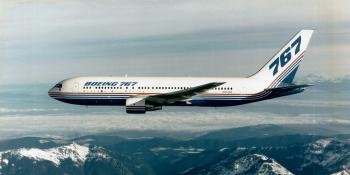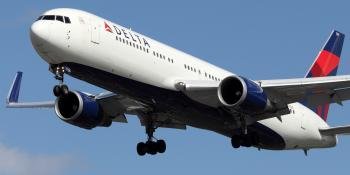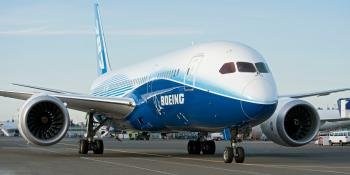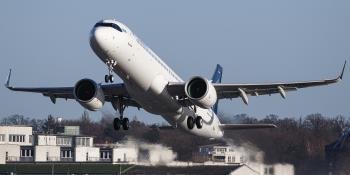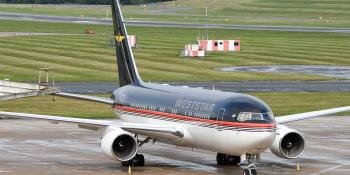Boeing 767
If you liked this collection of Boeing 767 article, a bookazine is also available from Key Publishing Shop
Shopping powered by Key Publishing Shop 
Conception and development of the Boeing 767, from the early 1970s to the service entry of the airliner.
Like many aerospace companies, Boeing suffered a dramatic downturn in its fortunes during the late 1960s and early 1970s as business declined during the world recession. In addition, the high cost of developing the Boeing 747 widebody and work on the abortive 2707 (previously 2733) Supersonic Transport had left its mark on the company; its workforce had shrunk by two-thirds to around 36,000. Nevertheless, the company needed to make plans for future products if it was to survive and prosper in the 1970s.
At the start of the decade the Commercial Airplane Group at Seattle, Washington, began the New Aircraft Programme to outline the needs of airlines in the next ten to 15 years and identify new airliners that could complement or potentially replace its existing Boeing 707, 727, 737 and 747 families.
In August 1971 the company released the first image of a design associated with the designation Boeing 767. Able to carry up to 200 passengers and with a cruising speed of Mach 0.98, the airframe was powered by four turbofans, two of which were mounted under highly swept wings and another pair on the rear fuselage. The fuselage was area ruled to reduce drag at high speed, while a T-tail had swept vertical and horizontal surfaces.
STOL plans
Another study covered a quiet short-haul short-take-off and landing (STOL) airliner with a capacity for 100 to 150 passengers. It had a high-position augmentor wing with blown flaps, a T-tail and four podded engines under the wings. Known by the project number 751, the aircraft would serve on routes of 435nm (805km) to 695nm (1,287km) flying at Mach 0.80. Development was to be undertaken in collaboration with Aeritalia of Italy, with a new production facility to be established in the south of the country from which the airliner would be assembled, mirroring the site in the US.
Work on the 751 progressed as far as the modification of a NASA de Havilland Canada C-8A Buffalo with an augmentor wing and two Rolls-Royce Spey 801-SF turbofans in place of the original General Electric T64 turboprops. The demonstrator flew on May 1, 1972, but it was quicky determined that the noise levels were too high for operation from regional airfields with runways from 2,500ft (762m) and the design would be uneconomical. While the 751 was overhauled as the Quiet Short Haul (QSH) jet transport for operation from local, secondary airports – albeit from longer runways than originally envisaged – the prioritising of airfield performance negatively impacted operational economics.
The Boeing 751 is important to the 767 story for two reasons. The project number was used for most of the subsequent designs that would eventually result in the 767. It also introduced Aeritalia to the programme.
Boeing replaced studies into the QSH with a new advanced airliner programme in September 1972. The title 7X7 was applied, indicating that the new aircraft was intended to fit within the company’s wider airliner family, although the project number 751 was retained for the numerous designs investigated. Selected airlines received presentations on the 7X7 from early 1973 to generate feedback on which way the project should progress. Boeing planned to launch a new airliner by the start of 1974 and introduce it into service by the end of 1977, but this proved to be overly optimistic. It would be a further four years before the design of the 7X7 was firmed up.
Searching for consensus
Several factors were considered for the new airliner, including noise levels at airports. The development of new high bypass fan engines promised significant reductions in noise as well as improvements in efficiency. The fans had lower exhaust velocities, revised intake and exhaust designs, and acoustic linings. As the 7X7 had not been firmed up and different 751 designs were tailored to medium- or long-haul routes, the exact number of engines required – two, three or four – remained fluid. It was expected that if the 7X7 was adopted for medium range operations, carrying around 140 passengers on routes of 2,500nm (4,630km), the aircraft would require a pair of turbofans rated at around 40,000lb st (177.9kN), with the General Electric CF6, Pratt & Whitney JT9D and Rolls-Royce RB211 potential candidates.
Consideration was also given to the positioning of the engines, with investigation into mounting them above the wing ahead of the leading edge, which would lower noise experienced by those on the ground by using the wing to shield the exhaust. While it also generated additional lift, it imposed structural and temperature problems on the wing and was soon abandoned.
For longer range operations carrying around 200 passengers a third turbofan was considered, with one installed in the root of the tail and two under the wings. The cabin would accommodate between six and eight abreast, with Boeing looking at double lobe fuselages as well as conventional circular sections. Four shoulder mounted Pratt & Whitney JT10Ds of 26,700lb st (119kN) were originally expected to power a 200-passenger variant with range of 5,000nm (9,262km), but by 1974 the engines had been repositioned under the wings.
While multiple 751 proposals were generated by the mid-1970s, they failed to get Boeing any closer to generating a clear idea of the airliner required by the airlines. A number of airlines were contacted by the manufacturer in order to clarify the situation, with United Airlines acting as the contact to co-ordinate data from the US carriers. Although no consensus on the design could be reached among potential operators, United would go on to play a significant role in the 767 programme.
Two variant approach
At the Paris Air Show at Le Bourget, France, in June 1975 Boeing and Aeritalia displayed a model of the three-engine 7X7, but with a low horizontal tail and widebody, smaller than but superficially resembling the Lockheed TriStar in configuration. The layout was optimised for long haul, while work also continued on a twin-engine version for shorter routes. Both had a thick section, aft-loaded advanced supercritical wing design to reduce drag and increase fuel efficiency, but fuselage length and cross-section, range and payload, and powerplant remained undefined.
It was envisaged that the medium-range variant would be offered initially, with development of the longer-range version expected some two years later, using funds generated by sales. This plan was formulated to overcome the high interest rates prevalent in the mid-1970s, which made it difficult to recover the development costs for a completely new design over the production run.
Further definition resulted in two fuselage lengths, able to accommodate between 175 and 201 passengers, or up to 283 in all-economy configuration. The cross section was set at 16ft 6in (5.03m) to permit seven abreast seating. Ranges offered were up to 2,160nm (4,000km) for European airlines, increasing to 2,700nm (5,000km) for US domestic carriers and 4,860nm (9,000km) on intercontinental services. The airlines would be able to select from between five powerplant options.
Considerable effort was made by Boeing to reduce the costs not only of manufacture but also of operation. These included the use of the then novel, light weight composite materials and advanced aerodynamics. The 7X7 would also benefit from an integrated digital system for flight control and navigation, which would allow the flight crew in the cockpit to potentially be reduced to just two pilots, dispensing with the flight engineer. In order to help facilitate this the 7X7 would have cathode-ray tube (CRT) displays in place of the traditional analogue instrumentation, reducing the workload in the cockpit. However, the decision to use a two-person cockpit was only taken during the flight test campaign.
Twins and trijets
Boeing expected to be able to sell 1,000 7X7s over 15 years, taking into consideration worldwide growth in travel and the number of extended range non-stop services. Around half of the predicted sales would come from US carriers serving trunk routes. The manufacturer wanted to secure orders from two major US carriers and one foreign operator to launch the programme, with development expected to require four years prior to initial deliveries in late 1980 or early 1981. Aeritalia became a risk-sharing partner in the 7X7 with a 20% stake, with the Italian government having invested $230m in a new production facility.
By the middle of 1976 studies focussed on the 7X7-962 twin and the 7X7-963 trijet. The 7X7-962 had a double lobe fuselage with a width of 17ft 6in (210in) able to accommodate eight abreast. A twin aisle configuration seated 180 in tourist- and 20 in first-class. It had high aspect ratio wings and a low horizontal tailplane, but would require more powerful engines than the trijet to cope with the possibility of a failure of one of the powerplants. Composites were to be used for a range of components, including many of the flying controls, the floor panels and wing leading edges, reducing weight and easing maintenance.
The 7N7
By the mid-1970s Boeing was investigating a smaller capacity narrowbody as the 7N7 (project number 761) in parallel with the 7X7, with high commonality with the 737 airframe. Fuselage lengths for 154 or 169 passengers were proposed, with a range of 2,000nm (3,704km) powered by either CFM International CFM56s or Pratt & Whitney JT10Ds. By June 1977 a new airframe had been adopted for the 7N7, with a T-tail (which had also been readopted by the 7X7), while it accommodated just 20 fewer passengers than the widebody. The primary differences between the two related to range, over water operations, and freight capability (the 7X7 being able to carry 16 LD3 containers).
The fuselage cross section of the 7N7 was later increased to carry seven abreast, but returned to that of the 727 prior to becoming the Boeing 757 in February 1978. Although Boeing courted British Aerospace to produce the wings of the 757, the UK company elected to join Airbus Industrie instead. British Airways and Eastern Airlines helped define the new airliner, which eventually emerged as a 180-seater. Compared to the 7X7, the 7N7 had a relatively smooth genesis.
7X7 becomes 767 and 777
A launch for the 7X7 was hoped for in October 1977, but was again frustrated by US airlines disagreeing on the width of the fuselage and number of powerplants. By the end of the year the company decided to progress with the twin first – a reversal of its earlier priorities – and had reverted to the 16ft 6in (5.03m) cross section. In January 1978 the company announced it would expand its facility at Everett and in mid-February the designations 757 (for the 7N7), 767 (7X7 twin) and 777 (7X7 trijet) were allocated. It was hoped launch orders and go-ahead would be received by the middle of the year.
The 767-100 was aimed at American Airlines’ requirement to carry 175 passengers over 2,000nm (3,704km), while the 767-200 had the same range but two more rows of seven abreast. Able to accommodate 175 passengers, the transcontinental 777-100 would operate over 2,700nm (5,000km) and the 777-200 4,500nm (8,334km). All four variants shared a common flightdeck, wing, fuselage cross-section and tailplanes.
It quickly became clear that the 767 was gaining traction with potential customers, with United Airlines expressing firm interest in the -200. By May 1978 Boeing was planning on certification and initial deliveries of the variant in mid-1982, with the 777 to follow about nine months after. Production was to occur at Everett at an initial rate of two per month.
On July 14, 1978, United Airlines placed the launch order for the 767-200, the new design having overcome a rival offer from Airbus for the A310. The carrier committed to 30 767s and placed an option for a further 37 in November 1978. Including spares, simulators and training, the deal was worth $1.2bn. United firmed up nine of the options in September 1980.
The airliner would have a twin lobe fuselage with a cross section of 16ft 6in (5.03m) for up to 197 passengers in seven abreast seating, a low set horizontal tailplane (changed from a T-tail weeks before the order) and two Pratt & Whitney JT9D-7Rs, a derated variant of the turbofan that powered United’s Boeing 747s. As detailed design work continued the twin lobe fuselage was replaced by one with a circular section, permitting stowage of up to 22 LD2 containers in the underfloor hold.
Subcontracts were let to Grumman Aerospace (for the wing centre section and adjacent lower fuselage, plus bulkheads); the Vought Corporation (horizontal tail); Canadair (rear fuselage) and Aeritalia (wing control surfaces, wingtips, fin, rudder and nose radome). In September 1978 the Civil Transport Development Corporation of Japan joined the programme, comprising Fuji (responsible for producing wing fairings and main landing gear doors); Kawasaki (centre fuselage body panels, exit hatches, in-spar ribs in the wings) and Mitsubishi (rear fuselage body panels, stringers, passenger and cargo doors, dorsal fin).
Additional orders
In August 1978 British Airways and Eastern Airlines committed to 19 and 21 Boeing 757s, respectively, although the manufacturer only confirmed go-ahead in March 1979. Faced with the expense and workload of developing two new airliners, the decision was taken to drop plans for the 777-100/200. The end of the 777 was triggered by American Airlines order for 30 767-200s, plus options for another 20, on November 15, 1978. It was determined that additional versions of the 767 twin could be developed later to fill the niches at which the 777 was aimed. On the same day as American placed its order, Delta Air Lines signed for 20 worth $1.7bn, plus 22 options. Both stipulated CF6-80As turbofans for its aircraft with enough range for transcontinental operations. By the end of 1978 Boeing held firm orders for 84 767s (including a four aircraft commitment from Pacific Western Airlines [PWA] of Canada, later reduced to two) and options on another 81 (two from PWA).
The year 1979 saw Boeing record commitments for 767s from five customers. Early in the year a letter of intent from International Lease Finance Corporation covered ten (later confirmed as four 767-200ERs and three -300ERs), while in July Air Canada ordered 12 (plus 18 options), followed by All Nippon Airways (25, 15 options) in October 1979, then CP Air of Canada (four, not delivered). Trans World Airlines selected the 767 in December 1979, ordering an initial ten and placing options for a further ten.
Four airlines ordered the 767 in March 1980; Ansett Airlines of Australia (five), Britannia Airways (two), China Airlines (two) and Western Airlines (six, plus six options, all later cancelled). The second European customer, Braathens of Norway, signed for two 767-200s (plus two options) in April 1980. Three were ordered by Avianca of Colombia in December 1980, with options for another four, while Alaska International committed to two (plus two options) the same month after deciding to start passenger operations. These plans were later abandoned, as was the order for the 767s.
Boeing’s order book for the 767 increased by four in March 1981 when El Al of Israel signed for the aircraft to replace 707s. The aircraft were delivered as two 767-200s and two -200ERs. Three (plus five options) were ordered by Transbrasil in August 1981, while in the last month of the year Ethiopian Airlines committed to two 767-200ERs (plus two options). By then, the first 767 was flying, but no further orders were received by October 1982 when Thai Airways committed to two. These airliners were never confirmed, however, Thai instead turning to Airbus.
Test campaign
A considerable amount of wind tunnel testing – over 26,000 hours – was undertaken by Boeing to develop and confirm the external configuration of the 767. A complete static airframe was allocated for structural testing, which was undertaken over three phases. The first covered the design loads expected to be encountered during normal service, which was increased in phase two to represent those of higher weight derivatives of the basic airframe. After the completion of these tests the airframe was subjected to ultimate load trials that ended with the destruction of the specimen. An additional representative airframe took part in fatigue tests from April 1982; one year later 50,000 flights had been simulated.
Construction of the first Boeing 767-200 (N767BA, c/n 22233, VA001) began on July 6, 1979. It was rolled out at Everett in front of representatives of the airline industry, press and company workers on August 4, 1981. A Boeing-owned airframe, it was fitted with a pair of Pratt & Whitney JT9D-7R4 engines. At the time some work remained to be undertaken on the aircraft prior to its first flight, but on September 26 project test pilot Tommy Edmonds departed the runway at Paine Field after rolling for around 3,000ft (914m) for the airliner’s maiden flight. During the 2hr 4min sortie the test crew of Tommy Edmonds, Lew Wallick, and John Brit evaluated the airliner’s general handling between 102kt (189km/h, the stall buffet speed at 240,000lb/108,862kg) and 225kt (417km/h). Operation of the landing gear and speed brake was evaluated with the flaps up and down, with the control surfaces deflected to the 30° landing setting. No major issues were noted during the flight, with the pilots highlighting the functionality of the cockpit CRT displays shared with the 757. The milestone flight had been achieved three days earlier than originally scheduled in 1978.
The first 767 was allocated to flight airworthiness, control, stability and aerodynamic performance. Although the flight envelope was expanded to a speed of Mach 0.91 and altitude of 43,100ft (13,137m), poor weather at the end of 1982 initially delayed the test programme. From early December VA001 was based at Palmdale in California to perform minimum unstick velocity trials on the runways at nearby Edwards Air Force Base.
Certification of the 767 was set to occur on July 30, 1982, according to the date put forward by the manufacturer in December 1978. To achieve the target in just 10 months Boeing would use five 767s in the flight test campaign. Each of the aircraft would be fully equipped with test equipment, weighing around 30,000lb (13,608kg), partially because of the need to adequately confirm the safe operation of the new avionics. The CRT displays and the digital flight control systems, new laser-gyro inertial reference system, pitch augmentation control system and auto-throttles each needed to be tested. It was anticipated that around 1,100 to 1,300 flight hours would be required for certification. To achieve certification in the specified time, each aircraft was expected to fly about 30 hours a month.
VA001 was joined by 767-222 N601UA (c/n 21862, VA002) which made its first flight on November 4, 1981. The -222s were intended for United Airlines and were powered by JT9D-7R4s, with the variant accounting for three of the five 767s involved in the flight development programme. It joined the test programme on December 10 and was assigned the testing of controls, the digital avionics, electronics and engines. VA003 (767-222 N602UA, c/n 21863) made its maiden flight 20 days after the second. The leading-edge slat on one of its wings failed during its maiden flight, although it made a safe landing. While the problem was investigated the first 767 flew with the inboard sections of the slats locked down, while the second and third had them locked-up. VA003 was to participate in investigation of flight loads, stall and buffet characteristics, as well as pneumatic and automatic flight controls, including avionics, and began test operations on December 28.
The fourth aircraft (767-222 N603UA c/n 21864) was used for noise and aerodynamic measurements; it first flew on December 19, 1981 and 11 days later joined the test fleet. The fifth 767 to join the test fleet was VA301, the first -232 (N101DA c/n 22213) powered by CF6-80As. It first flew on February 19, 1982, with the mission of certifying the airframe with the General Electric engines from the following month. The process took six months, during which VA301 accumulated 230 flight hours in 239 sorties.
The flight test programme was later expanded to 1,600 flight hours, with 185 hours added when the decision was taken to standardise on a two-man flight deck crew for the 767, rather than the three originally expected. The change occurred after the publication of the findings of a presidential task force that looked into two-crew airliner flight operations that, along with the reduction in personnel costs, resulted in 16 of the 17 airlines with commitments for the Boeing 767 switching to the new configuration. This required a further airframe to join the test fleet, with the seventh 767 (-222 VA006 N605UA c/n 21866) selected. The aircraft was rolled out at Everett on January 16, 1982, with the three-person flightdeck and was modified before its maiden flight on March 25, 1982, becoming the first with a two-crew configuration.
VA006 joined the test programme on May 27 and had accumulated 60 flight hours before departing for a 15-day seven country demonstration tour of Europe and the Middle East on July 6. Turin in Italy was used as a base, with support provided by Aeritalia. The aircraft undertook 43 flights over nearly 81 hours during the tour, carrying representatives from airlines, governments, industry and the press, as well as undertaking functional and reliability testing monitored by Federal Aviation Administration officials that accompanied the airliner. The 767 was flown by various pilots, including Aeritalia’s test pilot and those from Alitalia and Ethiopian, as well as Jordan’s King Hussein. The opportunity was also taken to visit Luton and Oslo to demonstrate the aircraft to Britannia Airways and Braathens. It returned to Seattle direct from Oslo on July 20, setting a distance record for a twin-engine airliner of 4,333nm (8,025km) at an average speed of 441kt (816km/h) over 9hrs 50mins.
Boeing 767 certification
The 767 demonstrated flight characteristics similar to that of the 737. It was easy to fly, had light control forces and did not feel like a large aircraft. The pitch augmentation control system was found to be unnecessary, although seven vortex generators were fitted on each wing for certification for buffet at high Mach and altitude. In general, flight testing demonstrated that the 767 performance better than originally predicted. Drag was lower than expected and the aircraft had an empty weight below that predicted, reducing fuel burn and increasing range, as well as improving airfield performance and service ceiling.
A total of 24 aircraft had been rolled out by the time the FAA Type Certificate was awarded on July 30, 1982. These aircraft – and the six that followed – were modified for two-person operation, the standard to which all later 767s were built. The change in the cockpit had the benefit of greatly increasing commonality with the Boeing 757, which also shared common flight characteristics. This allowed a common type rating for the pilots of airlines operating both types to be issued by the FAA on July 22, 1983, reducing costs and increasing flexibility for operators.
Into service
The JT9D-powered 767-200 entered service on September 8, 1982, when United Airlines flew its inaugural flight with the airliner between Chicago, Illinois, to Denver, Colorado. Its first 767-222 (N606UA c/n 21867) had been delivered on August 19, chairman and chief executive of UAL Corporation Richard Jesse Ferris receiving the keys to the aircraft from Boeing president Malcolm Theodore Stamper during a ceremony at Everett. The ninth 767 completed, it was flown to San Francisco in California for preparation for service and named ‘City of Chicago’.
By the end of October 1982 United had received five 767s, by when daily utilisation had risen from 7hrs 30mins to 8hrs 12mins. Although the airline had increased its firm order to 39 767s, this was reduced to 19 aircraft in June 1982, a reflection of the poor state of the US economy and delays to rebuilding air traffic control capacity.
Delta Air Lines became the first to receive a CF6-80A powered 767 after the airframe/engine combination was certified in early October 1982. The previous month, Boeing exhibited 767-232 N102DA (c/n 22214) at the Farnborough International Airshow, the airliner’s public debut. The second 767 destined for Delta after N101DA used in the test programme, it had first flown on August 27, 1982. By the time of certification N101DA had around 315 flight hours and N102DA some 40 hours. The latter became the first delivered to Delta, on October 25, and was named ‘Spirit of Delta’, the cost of the aircraft having been raised by voluntary contributions by the airline’s staff. It was joined by the third example built for the airline (N103DA c/n 22215) four days later.
The General Electric 767 entered service on November 21, 1982 – not with Delta but with American Airlines. The first American 767-223 (N301AA c/n 22307) made its maiden flight on October 6, 1982, and was delivered to the carrier on November 4. Its inaugural service was between San Francisco and New York. Delta began 767 operations from its Atlanta, Georgia, hub on December 15.
